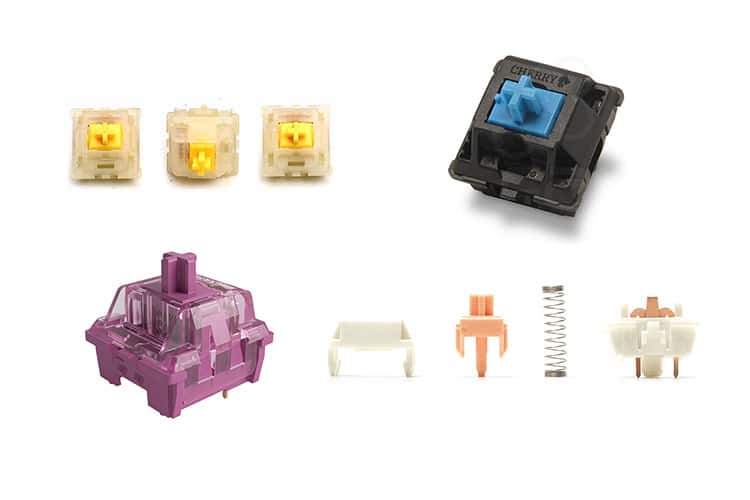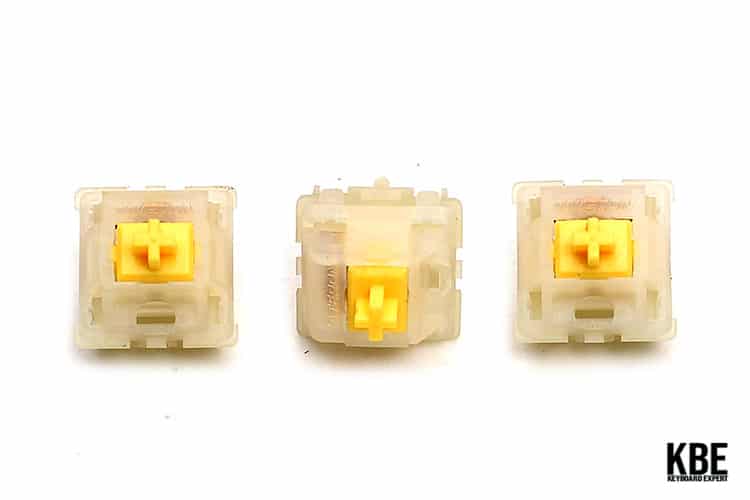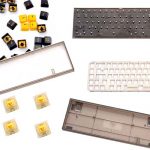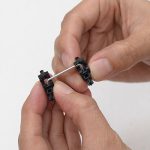
Unlike membrane keyboards, mechanical keyboards give the user more options in terms of how switches feel. Some switches are heavier while others are lighter. This factor that determines how a switch feels is generally referred to as actuation force.
Actuation force is one of the factors that affect a keyboard’s performance. It is the amount of pressure needed to press down a key and record a keypress. The concept of actuation force greatly helps users determine what kind of switches they want for their keyboard.
Understanding the concept of actuation force is incredibly important in the world of mechanical keyboards. They can help users understand what kind of switch they want. This also helps avoid trial and error, especially since most consumers cannot demo mechanical switches before buying them.
What is Actuation Force?

Every key on a keyboard requires a certain amount of pressure to press them down and hit the actuation point. An actuation point is a point where a keypress is registered after traveling the actuation distance, which is the distance each key has to travel to make an electrical contact. After hitting the actuation point, there is no more need to fully press down a key which leads to faster typing.
To hit the actuation point and activate the switch, a definite amount of force is needed, which is labeled as actuation force. This metric is usually measured in grams. Its value may vary depending on what type of switch is going to be used on a customized mechanical keyboard. Various types of switches have different designs and characteristics which require different actuation forces.
The spring’s weight, which is sometimes mistaken by people as the actuation force, does not affect the value of the latter. However, the length of the spring, the force of the spring, travel distance, shape of the stem, and others more may affect the value of the actuation force. Some switches require just a slight amount of actuation force which is easier to press, while others require a heavier actuation force.
How Does Actuation Force Affect Typing and Gaming?

Having a lighter or heavier actuation force has its pros and cons. Switches that need a lighter actuation force can register a keypress more effortlessly than heavier ones. This can be very useful while playing a game where a player needs not just fast hands but also the help of a fast keyboard. Users will also not get tired that easily in the long run because it needs less effort to activate a switch.
However, the downside of these lighter switches is they are prone to accidents. Mistakes may often be made while typing or playing a game when using switches with lower actuation force. Energetic fingers may at times unexpectedly press a key, and your game would be over. Well, some users are already used to using lighter switches, but some tend to like heavier ones.
Switches with higher actuation force requirements need a harder press and can wear your hands and fingers after quite some time. The volume of strain caused by this kind of switch may vary from user to user. Even so, this can help prevent miss-presses that are often experienced with the light switches.
Which Actuation Force is the Best?

Users’ likes and wants may differ from each other. Hence, choosing which actuation force is the best will still be based on each other’s personal preference. Some gamers and/or writers may like soft, quiet, and easy to press switches. However, others may want more tactile, bumpy, and heavy switches with loud clicking noises.
In circumstances where you don’t want to disturb someone, like in an office setting, switches with lower to moderate actuation force may be advised to use. It may be inappropriate to annoy your neighbors with irritating noises while working. Therefore, using linear type switches is recommended in this kind of situation.
Linear-type switches may be soft and quiet, but they are prone to accidentally entering a key with just a slight graze. That is why it is likely for writers to use switches with moderate to a higher actuation force. This type of switch is helpful for them to be able to feel if a keystroke is being registered. Well, for gamers, it may vary depending on their taste, but mostly a switch with just a moderate actuation force is favored.
Common Switches and Their Actuation Force
Gateron Milky Yellow

Gateron Milky Yellow switch has an actuation force of 50g and an actuation travel distance of 2.0mm before it hits the actuation point. Its total travel distance is 4.0mm and has a bottom-out force of 65g. These switches are manufactured by Gateron, as indicated in its name, which is a company that is mainly engaged in the manufacture, design, and development of various switches.
It has a yellow stem with a milky top and bottom housing where its name was derived. This type of switch typically has the characteristics of a linear switch which has a medium actuation force with a quiet noise. This can be good to use in an office environment since you can’t disturb your neighbor with its quietness.
Gateron switches also come with other colors with different characteristics, but Milky Yellow is one of the most recommended out of them as the middle ground, which has a good response but is not too forceful. The smoothness and a quiet touch of each key make them perfect for both typing and gaming. Applying the preferred amount of lubed would make it the best though it may come with a little pre-lubed from the factory.
Cherry MX Blue

This type of switch falls under the category of clicky switches. It usually requires a significant amount of actuation force and has a higher reset position, thus making the performance a bit slower in situations where a user may need a faster response. Users who would rather choose a loud and more precise key press confirmation would definitely like this type of switch.
Cherry MX switches have many available variants with different stem colors, which also have different characteristics. Aside from MX Green, the MX Blue switch, which has a blue-colored stem, is one of the switches with strong tactile feedback produced by Cherry MX. Due to its loud and sometimes irritating noise, these switches are not ideal to use in an open space work environment. However, most writers would rather have this kind of switch because it has more definite and noticeable feedback.
The actuation force needed for Cherry MX Blue usually was 50g, but newer batches came with 60g. Its bottom-out force is also 60g with an actuation distance of 2.0mm or 2.2mm and a total travel distance of 4.0mm. It is one of the popular Cherry MX switches. They may be noisy, but many users do prefer hearing these loud click noises with each keypad they press.
Gateron Ink Black V2

The previous V1 variant of Gateron Ink Black was known for its deeper sound, which is greatly recommended as an option for choosing a linear switch. However, it had issues with the contact leaves becoming loose. So a brand new version was designed to solve this problem. By preserving its other positive characteristics, the manufacturer has created a probable solution.
Gateron Ink Black V2 has an actuation force of 60g with an actuation distance of 2.0mm. Its bottom-out force is 70g with a total travel distance of 4.0mm. It is a linear type of switch which has a quick rebound because of its stability, smoothness, and excellent performance.
Gateron Ink switches are known for their translucent smokey housing. Now, their V2 switches offer a new and enjoyable typing experience. With an upgraded housing, which is made with a new type of plastic different from its old version, it now secures and helps prevent the fallout of contact leaves. The stem is normally colored black, but the spring also has a new black coating to help lessen the spring noise.
Glorious Panda

The first thing that stands out from a Glorious Panda switch is its stem with a golden bright orange color that easily catches the eye. It has an ivory white colored top and bottom shell created from the original Invyr Panda switch housing material, which is then modified to integrate the branding of Glorious Panda. The manufacturers also added something new and enhanced the material and internal design.
This kind of switch has an approximately 67g of actuation force with less pre-travel or actuation distance. As a tactile switch, it has a snappy response as it hits the bump at the beginning of the keypress then quickly snaps back as you release the pressure. Its performance perfectly fits a balanced high tactile switch.
It may produce a slight scratch sound at first when using it moderately. However, if you try to use it at a higher activation speed, it may start to annoy you with a strange noise. To fix this slight change in the sound, a little application with lube will solve it.

The KBE team is dedicated to sharing our knowledge and creating useful resources about computer keyboards. This article was written as a team collaboration, combining our knowledge and years of experience using, building and modding keyboards. Meet the team here.



